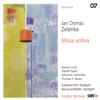Zelenka Missa votiva
A quirky Mass of thanksgiving that mingles the solemn and the jolly
View record and artist detailsRecord and Artist Details
Composer or Director: Jan Dismas Zelenka
Genre:
Vocal
Label: Carus
Magazine Review Date: 11/2010
Media Format: CD or Download
Media Runtime: 0
Mastering:
Stereo
DDD
Catalogue Number: CARUS83 223

Tracks:
| Composition | Artist Credit |
|---|---|
| Missa Votiva |
Jan Dismas Zelenka, Composer
Daniel Taylor, Countertenor Frieder Bernius, Conductor Jan Dismas Zelenka, Composer Joanne Lunn, Soprano Johannes Kaleschke, Tenor Stuttgart Baroque Orchestra Stuttgart Chamber Choir Thomas Bauer, Baritone |
Author: Richard Lawrence
The Missa votiva is a late work, composed in 1739 after Zelenka’s recovery from an unspecified but evidently debilitating illness. It’s scored for soloists, four-part chorus and an orchestra consisting of oboes and strings; the oboe parts, which simply double the violins or the voices, could easily be omitted. There’s old-fashioned counterpoint, sometimes severe, and contemporary galanterie, sometimes jolly. A non-jolly example of the latter is the Benedictus, for soprano and muted strings, sweetly sung here by Joanne Lunn.
The Kyrie eleison – which reappears at the end, note for note, as Dona nobis pacem – is a good example of both aspects: the orchestral introduction includes a chromatic unison phrase which in due course gets adopted by the chorus as a fugue subject. In general, Zelenka writes bass-lines that are firm of purpose, although he sometimes relies overmuch on sequential figures, as in “Cum Sancto Spiritu”. Jagged phrases abound which, given due weight by Frieder Bernius, add solemnity even to otherwise cheerful movements such as the “Christe eleison”. Zelenka’s one miscalculation is to follow “et sepultus est” with a 36-bar ritornello before the chorus enters with “Et resurrexit”.
Joanne Lunn shines in all three of her solos and Thomas E Bauer is splendidly bluff in “Quoniam tu solus sanctus”. Daniel Taylor is hypnotically beautiful in “Et incarnatus”, the strings’ paired quavers reminiscent of a Lullian sommeil scene. Bernius and his Stuttgart forces make a strong case for this quirky piece; and, apart from a backwardly recorded organ continuo, the balance is excellent.
Discover the world's largest classical music catalogue with Presto Music.

Gramophone Digital Club
- Digital Edition
- Digital Archive
- Reviews Database
- Full website access
From £8.75 / month
Subscribe
Gramophone Full Club
- Print Edition
- Digital Edition
- Digital Archive
- Reviews Database
- Full website access
From £11.00 / month
Subscribe
If you are a library, university or other organisation that would be interested in an institutional subscription to Gramophone please click here for further information.




